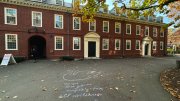I am quite sure that I never intended to travel the road of the mystery writer," wrote Earl Derr Biggers '07 for his twenty-fifth class reunion report. "Nor did I deliberately choose to have in the seat at my side, his life forever entangled with mine, a bland and moon-faced Chinese. Yet here I am, and with me Charlie Chan. Thank heaven he is amiable, philosophical--a good companion. For I know now that he and I must travel the rest of the journey together."
Biggers, whose Asian detective inaugurated the golden age of American mysteries, was selling short fiction to popular magazines while still a member of the Advocate and the Lampoon. After graduating, he worked briefly at the Cleveland Plain Dealer and at Bobbs-Merrill before settling at the Boston Traveler in 1908, first as a daily columnist, then as drama critic. There he met Eleanor Ladd who, together with New England and journalism, influenced his writing: most of his works contain a New Englander, a journalist, and an independent young woman. When new owners fired him from the paper in 1912, Biggers began his first novel. Huddled near the coal grate in his Mount Vernon Place room, he munched peanut brittle and wrote a chapter a day. Seven Keys to Baldpate, published a year later by Bobbs-Merrill, enabled him to marry Ladd and assured him national fame. The New York Times praised the book and showman George M. Cohan secured the dramatic rights, producing and starring in the Broadway play, which ran for 320 performances.
Described by friends as "short, round, and dark" and by his wife as "a Middle West product with a Boston complex," Biggers loved food, travel, and golf. A skilled raconteur with a fine sense of humor, he finished a second novel, Love Insurance, in New York, then turned it into a successful play, See-Saw. But further theatrical collaboration, while enhancing his reputation, exhausted him physically, emotionally, and creatively. On an extended family vacation, he reached Hawaii in 1920, sunned on the beach at Waikiki, plotted the perfect murder...and saved it for the right hero. "I had seen movies depicting and read stories about Chinatown and wicked Chinese villains," he explained years later, "and it struck me that a Chinese hero, trustworthy, benevolent, and philosophical, would come nearer to presenting a correct portrayal of the race."
Charlie Chan in fact secured the protagonist's role intended for young Bostonian John Quincy Winterslip, who encounters murder in Honolulu in The House without a Key, serialized in the Saturday Evening Post in 1925, and then published by Bobbs-Merrill. Though Winterslip is the romantic center of the novel, Chan--self-possessed, intelligent, humble, and tenacious--is the focus of reader and character attention. After saving Winterslip's life, Chan basks in pleasure: "I have saved a life here and there, but never before one that had beginning in cultured city of Boston. Always a happy item on the golden scroll of memory."
Biggers, a master of plot, characterization, humor, and timing, recognized the public's love of Chan. In 1925 he moved to Pasadena, where he wrote The Chinese Parrot, in which the Chinese-Hawaiian Chan's cultural complexity emerges further. While working in disguise, Chan speaks pidgin English but draws the line at one word: "[B]y the bones of my honorable ancestors, I will not say velly." The Post paid $25,000 to serialize the third Chan book, Behind That Curtain, and Biggers sold the story to Fox for "a very gratifying sum." Chan's world-wide popularity pleased Biggers but also worried him: "I don't want to find myself in a position where the public won't accept anything but a Chan story from me," he lamented. Promising Bobbs-Merrill a fourth Chan, he returned to Hawaii for inspiration and met with Chinese-Hawaiian police detectives, among them Chang Apana, whom he had read about years earlier: a man with dark, piercing eyes who worked for the Honolulu police, lived on Punchbowl Hill, and had many children--like Chan. Apana, however, was small and wiry and wielded a ferocious bullwhip, and there is no indication that he quoted aphorisms. Biggers always asserted that he had not based Chan on any real person, but he sent Apana an autographed copy of The Black Camel.
Just as Biggers seemed determined to write a non-Chan novel, the stock market crashed: as a result, he stuck with sure success, producing Charlie Chan Carries On and Keeper of the Keys, writing at a pace that strained his health. The latter appeared in 1932: a year later, Biggers died of a heart attack. Obituaries commended him for aiding the cause of international understanding and for paying tribute to the Chinese role in building the cities, orange groves, and vineyards of the Coast; a Plain Dealer editorial called Chan the most appealing supersleuth since Sherlock Holmes.
Hollywood and television have kept Chan going despite protests about caricatured aspects of the films. Chinese Americans such as Amy Tan, David Henry Hwang, and Gish Jen '77 now create their own literature for the public, yet Chan still looms in the background. Biggers realized the stature of his fictional hero when, near the end, he asked Bobbs-Merrill to make Chan's name on the cover "at least as large as mine. After all, he's the big boy."
Barbara Gregorich is the author of the award-winning Women at Play: The Story of Women in Baseball.





